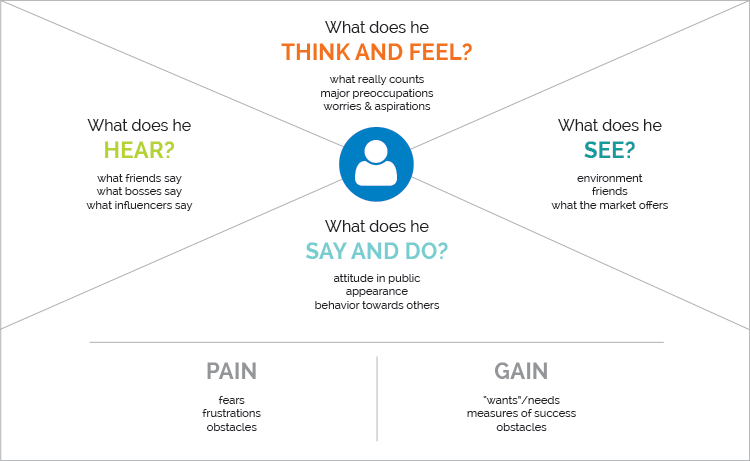Crafting a marketing message that will resonate with your buyers is no easy task. But, if you first determine the who, the what, and the how, you’ll be well on your way to a compelling message.
This week, in part four of this series, you’ll learn how to expand on what you’ve learned about the “how” thus far with an impactful tool called an empathy map.
Understanding is Vital
Empathy = understanding, and it’s something you cannot ignore.
If you want to understand your audience, you have to be able to enter the conversation that’s already playing in your prospect’s head. By matching up with their values and worldviews, you’re also aiming to open the conversation in the prospect’s heart, and that’s how your marketing triggers the right motivation at the right time.
The Process of Empathy Mapping
“Our ideal customer needs a better way to ____ because ____.”

Your empathy map will be different from anyone else’s, but it should have these foundational elements:
- Four quadrants broken down into “think/feel,” “see,” “say/do,” and “hear.”
- Two optional boxes at the bottom of the quadrants: “Pains” and “Gains.”
The point of this map is to easily organize your research and other relevant materials. The four quadrants represent the sensory experience of your ideal print buyer while in the prospect phase. To determine which quadrant your ideal buyer is in, ask yourself questions such as:
- What does a typical day look like in their world?
- What are their fears and hopes?
- How do they think about the problem you solve for them?
- What are they thinking when they resist solving the problem?
- How does your ideal persona feel about realistic options to solve their problem?
- What’s their environment like? Chaotic, mundane, slow-paced?
- What do they hope to get from buying your printing solutions?
No Pain, No Gain
Next, at the bottom of your map, draw two boxes and label them “pains” and “gains.” In the “pains” box, put your customers’ challenges and obstacles. To help you determine this, ask yourself the question, “what keeps my customer up at night?”
Then, in the “gain” box, include the goals of your ideal persona. Think, “what motivates my customer to solve their problem?” or “what are their hopes and dreams for their business?”
Document Your Persona to Get Your Message Right
You’re now ready to create a written composite of your ideal buyer and persona.
Some businesses document their persona into a simple Word document with a few paragraphs or create them using a PowerPoint presentation. You might even have a graphic designer create a fictional caricature or cartoon of your ideal buyer.
This fictional buyer persona should be thought of like your bible. You want to document this and keep it in one place, where it describes in detail everything about your ideal buyer. You want to make sure this story is in one place where your sales and marketing teams can access it at any time for educational purposes.
The more you know about your buyer, and can reference in a pinch, the more powerful you’ll be in your sales situations.
Irresistible messaging
It may seem like a lot, but if you follow the who, what, and how steps, and create your buyer persona using the empathy map, you’ll finally be able to win deals and grow your print business using a combination of clear messaging, that’s compelling, persuasive, and irresistible.
Need help? Download your copy of the Empathy Map here.


